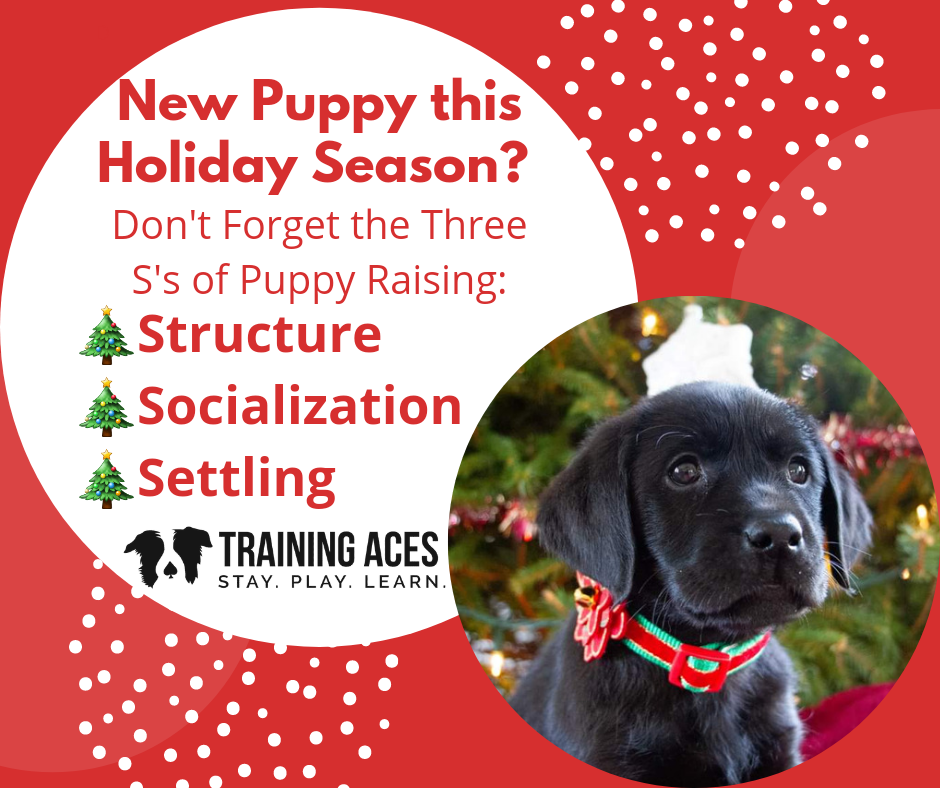The Three S’s of Raising a Puppy
The Three S’s of Raising a Puppy
You’ve bought big bag of the puppy kibble that the breeder suggested and some scrumptious treats for your new puppy to eat. You purchased the right size crate and a comfy bed. You picked out fluffy toys, squeaky toys, and chewy toys. Now it’s finally time to bring home your new puppy! You’re so excited, but then you start to wonder, how the heck do I raise this thing?! How do I make sure this cute little bundle of fluff grows into a happy, confident, well behaved dog?
Well you’re in luck, because as dog trainers, we happen to know a thing or two about puppy raising! When raising a puppy, the most important things to concern yourself with early on are the three S’s of Puppy Raising: Structure, Socialization, and Settling.
Structure:
You know the old phrase “an ounce of prevention is better than a pound of cure?” This absolutely applies to puppy raising! Whatever you allow your tiny adorable puppy to do now will definitely set the stage for what your puppy will do full grown. It’s much easier to prevent bad behaviors from the start by introducing structure and boundaries for your new puppy than it is to fix bad behaviors later. Things you should be doing to provide structure for your pup:
- ★Crate train and use the crate, even when you’re home. Puppies need a lot of sleep and a lot of down time - crate training will give your puppy a quiet place to relax, and crating while you’re home will help to prevent separation anxiety. If you can’t supervise your puppy, he should be crated to keep him safe.
- ★Keep a long, light weight leash on your puppy at all times - this will prevent your puppy from learning a lot of bad behaviors since he cannot play keepaway
- ★Never leave your puppy unsupervised - that is how they make potty training and other potentially dangerous mistakes
- ★Feed your puppy meals in his crate at designated times - do not free feed
- ★Don’t let your puppy do anything that you don’t want him to do when he’s an adult (eg. jumping on people, biting, etc)
Socialization:
Most people have heard that you need to “socialize” your puppy, but this term is actually quite misleading. Socializing is less about meeting new people and more about teaching your puppy how to positively interact with the human world as a whole. Here are a few quick socialization tips:
- ★Start socialization at home - introduce your pup to new sights, sounds, and surfaces in your house and your yard. Make a puppy playground, put on costumes, get creative! Keep experiences positive and use lots of treats as rewards!
- ★Practice passive socialization out in public - sit in the back of the parking lot - in or out of your car based on your puppy’s comfort zone and just let him soak up the new sights, sounds, and smells. Play some training games and enjoy each other’s company.
- ★Don’t do too much at once - keep outings short and don’t go out every day. Make sure your puppy has enough rest in between exploring new places
- ★Never force your puppy to interact with something that scares him - you want to gently guide your puppy with positive experiences
Settling:
Being calm isn’t something that comes with age - it’s something that comes with training. Learning how to settle is a very important skill for all dogs, and it’s especially important for puppies. Puppies have a hard time slowing down, and they often need guidance from their humans. Without enough rest, puppies can quickly get overwhelmed and this is often where unwanted behaviors like biting and jumping come in. To prevent this, we need to teach puppies that being calm is a good thing! Here are a few ways you can work on teaching your puppy so settle:
- ★Crate training is part of structure, but it’s also a part of settling. If crate trained properly, your puppy will learn to settle in his crate and will be able to do it no matter where the crate is.
- ★Practice having your puppy on a short leash next to you on the floor while you watch TV. You can start by feeding him his dinner a few kibbles at a time whenever he settles for a minute and up the duration of how long you ask him to do this a bit at a time.
- ★Practice having your puppy just sit next to you on a leash while you check scroll on your phone. This will help him learn to settle next to you, and you can eventually put this up to the test of having him sit quietly next to you while you talk to a friend
- ★Teaching your puppy to settle will teach him to control his impulses and behave more politely as he grows!

